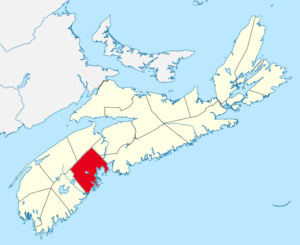Lunenburg County, Nova Scotia
| Lunenburg County | |
|---|---|
| County | |
|
Lunenburg harbourfront | |
| Nickname(s): "Christmas Tree Capital of the World"[1] | |
 Location of Lunenburg County, Nova Scotia | |
| Coordinates: 44°30′N 64°30′W / 44.5°N 64.5°WCoordinates: 44°30′N 64°30′W / 44.5°N 64.5°W | |
| Country |
|
| Province |
|
| Municipal district (s) | Chester / Lunenburg |
| Towns | Bridgewater / Lunenburg / Mahone Bay |
| Established | August 17, 1759 |
| Electoral Districts Federal |
South Shore–St. Margaret's |
| Provincial | Chester-St. Margaret's / Lunenburg / Lunenburg West |
| Area[2] | |
| • Land | 2,907.93 km2 (1,122.76 sq mi) |
| Population (2011)[2][3] | |
| • Total | 47,313 |
| • Density | 16.2/km2 (42/sq mi) |
| Time zone | AST (UTC-4) |
| • Summer (DST) | ADT (UTC-3) |
| Area code(s) | 902 |
| Dwellings | 24,786 |
| Median Income* | $43,257 CDN |
| |
Lunenburg County is a county located on the South Shore of the Canadian province of Nova Scotia, It ranges from Hubbards to the east and Vogler's Cove to the west.
History
Named in honour of the British king who was also the duke of Brunswick-Lüneburg, Lunenburg County was established in 1759, when peninsular Nova Scotia was divided into five counties. Three years later Lunenburg County was reduced in size when Queens County was established. Following the establishment of Queens County in 1762, Hants County in 1781, and Shelburne and Sydney Counties in 1784, the boundaries of all nine of the counties were defined by the Nova Scotia Council.
By Chapter 52 of the Statutes of 1863 the Township of Chester in the County of Lunenburg was made a separate district for certain specified purposes. That statute provided authority for the appointment of a Custos Rotulorum and for the establishment of a general sessions of the peace for the District of Chester, with the same powers as if it were a separate county.
Demographics
|
Mother tongue language (2011)[6]
|
Ethnic Groups (2006)[7]
|
Religious make-up (2001)<ref name="SC2001"/[8]
|
Communities
Incorporated communities
Towns
Municipal districts
Villages
Native reserves
Access Routes
Highways and numbered routes that run through the district, including external routes that start or finish at the district limits:[9]
|
|
See also
- List of communities in Nova Scotia
- Royal eponyms in Canada
- Black Lake listings within Nova Scotia.
- Lunenburg English, the distinctive dialect of the area
References
- ↑ http://www.terrysoff.com/lunenburg-county/christmas-tree-capital/
- 1 2 2006 Statistics Canada Community Profile: Lunenburg County, Nova Scotia
- ↑ Statistics Canada Population and dwelling counts, for Canada and census subdivisions (municipalities), 2006 and 2001 censuses - 100% data
- ↑ Censuses 1871-1941
- ↑ Statistics Canada: 1996, 2001, 2006 census
- ↑ Statistics Canada: 2011 census
- ↑ 2006 Statistics Canada Census Ethnocultural Portrait of Canada: Lunenburg County, Nova Scotia
- ↑ Religious make-up, for Lunenburg County, 2001 census - 100% data
- ↑ Atlantic Canada Back Road Atlas ISBN 978-1-55368-618-7 Pages 78-80, 86-87
External links
 |
Annapolis County | Kings County | Hants County |  |
| Queens County | |
Halifax County | ||
| ||||
| | ||||
| Atlantic Ocean |
